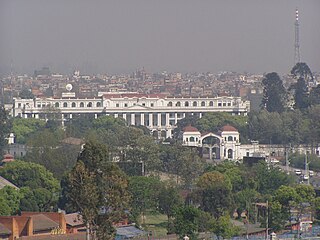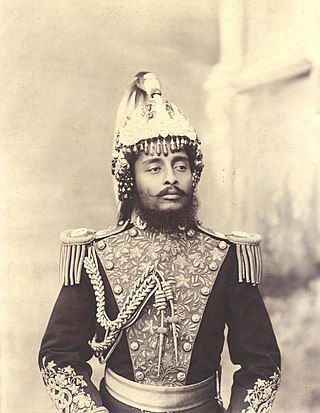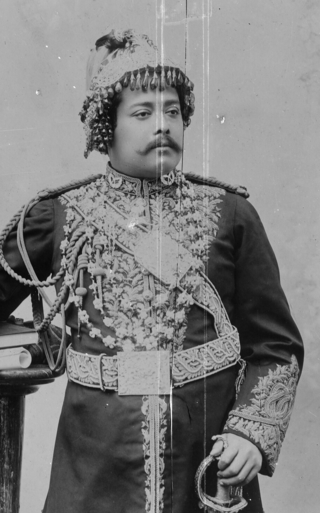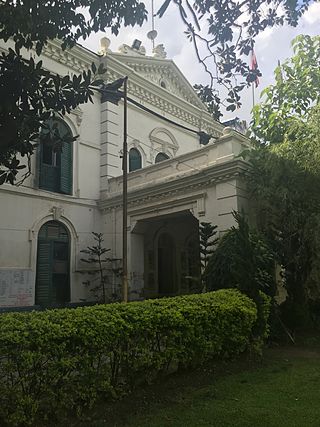
Singha Durbar is a palace in Kathmandu, the capital of Nepal. The palace complex lies in the centre of Kathmandu, to the north of Babar Mahal and Thapathali Durbar and east of Bhadrakali Temple. This palace was built by Chandra Shumsher JBR in June 1908. The palace used to be one of the most exquisite and lavish of palaces in the world until the 1950s. Today it houses buildings of the Nepali Government, including the Pratinidhi Sabha, the Rastriya Sabha and several ministries.

The Rastrapati Bhawan is the official residence of the President of Nepal, located in Kathmandu, Nepal. It hosts the Office of The President of Nepal. The main palace building is also known as Shital Niwas. It was built by Prime Minister Chandra Shumsher Jung Bahadur Rana in 1923.

Field-Marshal His Highness Maharaja Sri Teen Chandra Shumsher Jung Bahadur Rana was the Prime Minister of Nepal from the Rana dynasty. He served in this capacity from 27 June 1901 to his death in 1929 after he successfully deposed his liberal and reformist brother Dev Shamsher. Although generally perceived as despotic and conservative, he is credited with several reforms including the abolition of slavery and establishing the Nepal-Britain Treaty of 1923, which recognised Nepal as an independent nation and an ally of Britain.

The Narayanhiti Palace Museum is a public museum in Kathmandu, Nepal located east of the Kaiser Mahal and next to Thamel. The museum was created in 2008 from the complex of the former Narayanhiti Palace following the 2006 revolution. Before the revolution, the palace was the residence and principal workplace of the monarch of the Kingdom of Nepal, and hosted occasions of state.

Sri Maharaja, Dev Shumsher Jung Bahadur Rana was the Prime Minister of Nepal for 114 days in 1901. He was also the King of Lamjung and Kaski.

Ranighat Palace or Rani Mahal is a historic Rana palace located on the banks of Kali Gandaki River in Palpa district of Nepal. This palace was constructed by General Khadga Shamsher Jang Bahadur Rana in 1893.

Thapathali Durbar was a palace complex in Kathmandu, the capital of Nepal. Thapathali means abode of the Thapas. It was initially built by Nain Singh Thapa of the Thapa dynasty but was later occupied by Jung Bahadur Rana, as prime minister, the executive head of Nepal. The palace complex, located north of the Bagmati river, encompasses an impressive and vast array of courtyards, gardens, and buildings. Many palaces and buildings were built throughout late 1840s to 1900, initially by Nain Singh Thapa, a member of the aristocratic Thapa family and brother of Bhimsen Thapa, and later was acquired by Nain Singh Thapa's grandson Jung Bahadur Rana. Further additions were made by successive Ranas up to the 19th century.

Babar Mahal, Baber Mahal is a Rana palace in Kathmandu, the capital of Nepal. The palace complex, located north of the Bagmati river, was incorporated in an impressive and vast array of courtyards, gardens and buildings. Initially, the palace was under Jung Bahadur Rana's Thapathali Durbar but was later separated, demolished and rebuilt by Chandra Shumsher Jang Bahadur Rana, as prime minister and the executive leader of Nepal.

Kaiser Mahal is a Rana palace in Kathmandu, the capital of Nepal. The palace complex, located west of the Narayanhity Palace, was incorporated in an impressive and vast array of courtyards, gardens and buildings.

Bag Durbar, is a palace in Kathmandu, Nepal, west of the Dharahara and Tundikhel. Initially the palace was owned by Amar Singh Thapa (Sardar) of the Thapa regime and his descendant, but later was occupied by the Royals of the Shah dynasty, and later by the government of Nepal.

Bahadur Bhawan is a Rana palace in Kathmandu, the capital of Nepal. The palace complex, located west of Jamal, north of Keshar Mahal was incorporated in an impressive and vast array of courtyards, gardens and buildings. The palace was built by Bir Shumsher JBR and rebuilt by Rudra Shumsher JBR after its destruction by fire in BS 1962.

Lal Durbar is a Rana palace in Kathmandu, the capital of Nepal. The palace complex, located East of the Narayanhity Palace, was incorporated in an impressive and vast array of courtyards, gardens and buildings. Lal Durbar was built by Bir Shamsher JBR in 1890 CE.

Seto Durbar was a Rana palace in Kathmandu, the capital of Nepal. The palace complex, located south of the Narayanhity Palace, was incorporated in an impressive and vast array of courtyards, furnishings and guest halls. Seto Durbar was built by Bir Shumsher Jung Bahadur Rana in 1893 CE.
Jaulakhel Durbar was a Rana palace in Jawalakhel, Lalitpur, the capital city of Nepal. Jaulakhel Durbar was built by Bir Shumsher Jang Bahadur Rana in 1954 BS.

Lazimpat Durbar, Aka Agni Bhawan is a palace complex in Kathmandu, the capital of the Nepal. Initially build and occupied by Kaji Bir Keshar Pande but later palace area was occupied by Bir Shumsher JBR, as prime minister the executive head of Nepal. The palace complex, located next to the historic Narayanhity Palace Museum, was incorporated impressive and vast array of courtyards, gardens and buildings.
Lakshmi Niwas is a Rana palace in Maharajgunj, Kathmandu, the capital of Nepal. The palace complex, located north of the Bagmati river, was incorporated in an impressive and vast array of courtyards, gardens and buildings. It was built by Chandra Shumsher JBR, at the time prime minister and the executive leader of Nepal.

Gehendra Shumsher was a Nepali innovator, firearm designer, and general in the then Nepali Army. He was the eldest son of Bir Shumsher, the third prime minister of the Rana dynasty. He is generally regarded as the first scientist of Nepal.

Harihar Bhawan is a Rana palace in Patan, the capital of Nepal. The palace complex, located west of the Shree Durbar, was incorporated into a vast array of courtyards, gardens and buildings.

Shree Durbar is a Rana palace in Kathmandu, Patan, Nepal the capital of Nepal. The palace complex, located east of the Lazimpat Durbar next to Patan Dhoka, was incorporated in an impressive and vast array of courtyards, gardens and buildings. Sri Durbar was built by Chandra Shumsher JBR in 1927.

Rani Jagadamba Kumari Devi (1918–1988) was the wife of Lt.-Gen.Madan Shumsher JBR, and daughter-in-law of Maharaja Prime Minister Chandra Shumsher JBR. Jagadamba Kumari Devi was born in Balrampur district, Uttar Pradesh. After marriage with Lt.-Gen. Madan Shumsher JBR she moved to Kathmandu and lived in Shree Durbar.

















